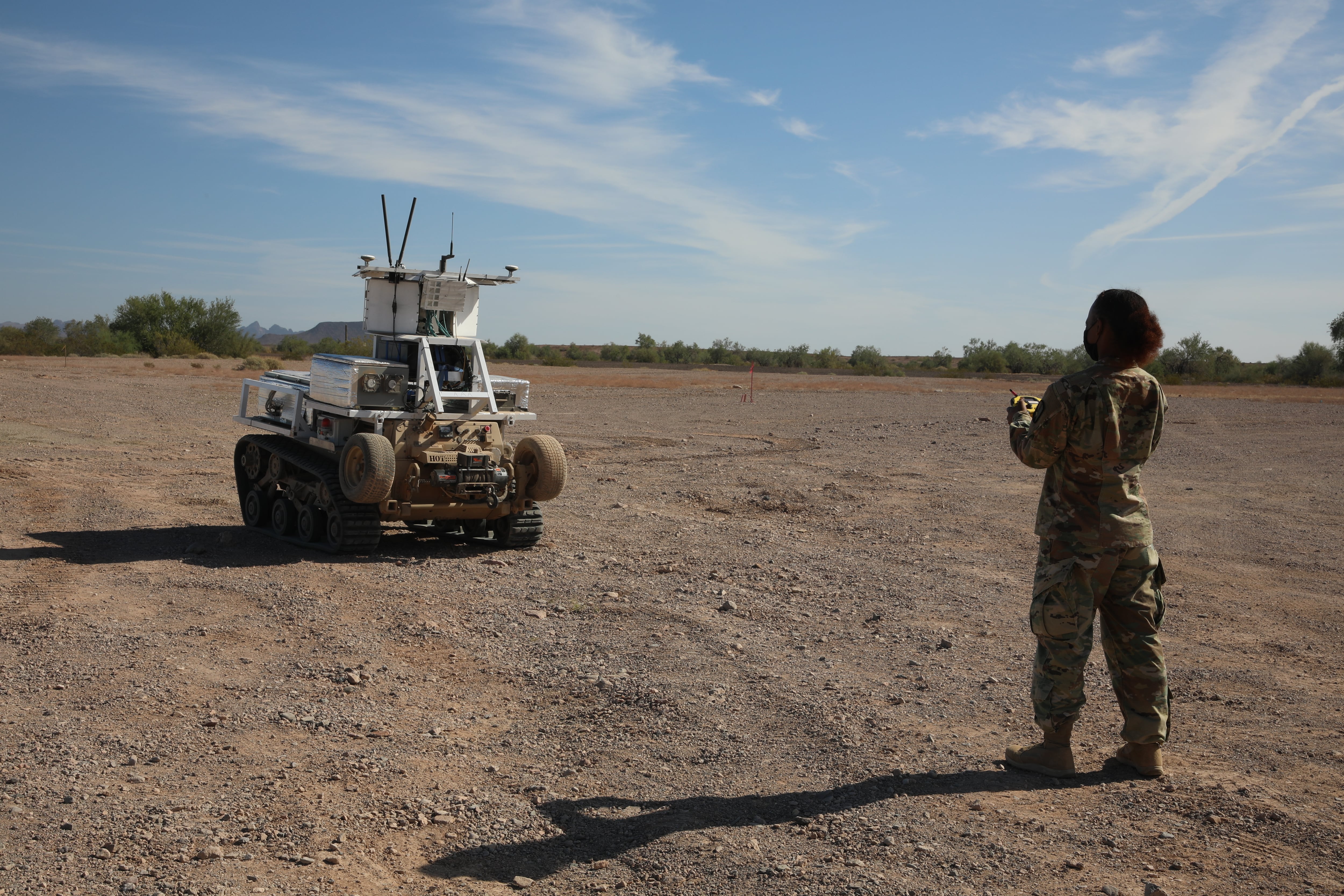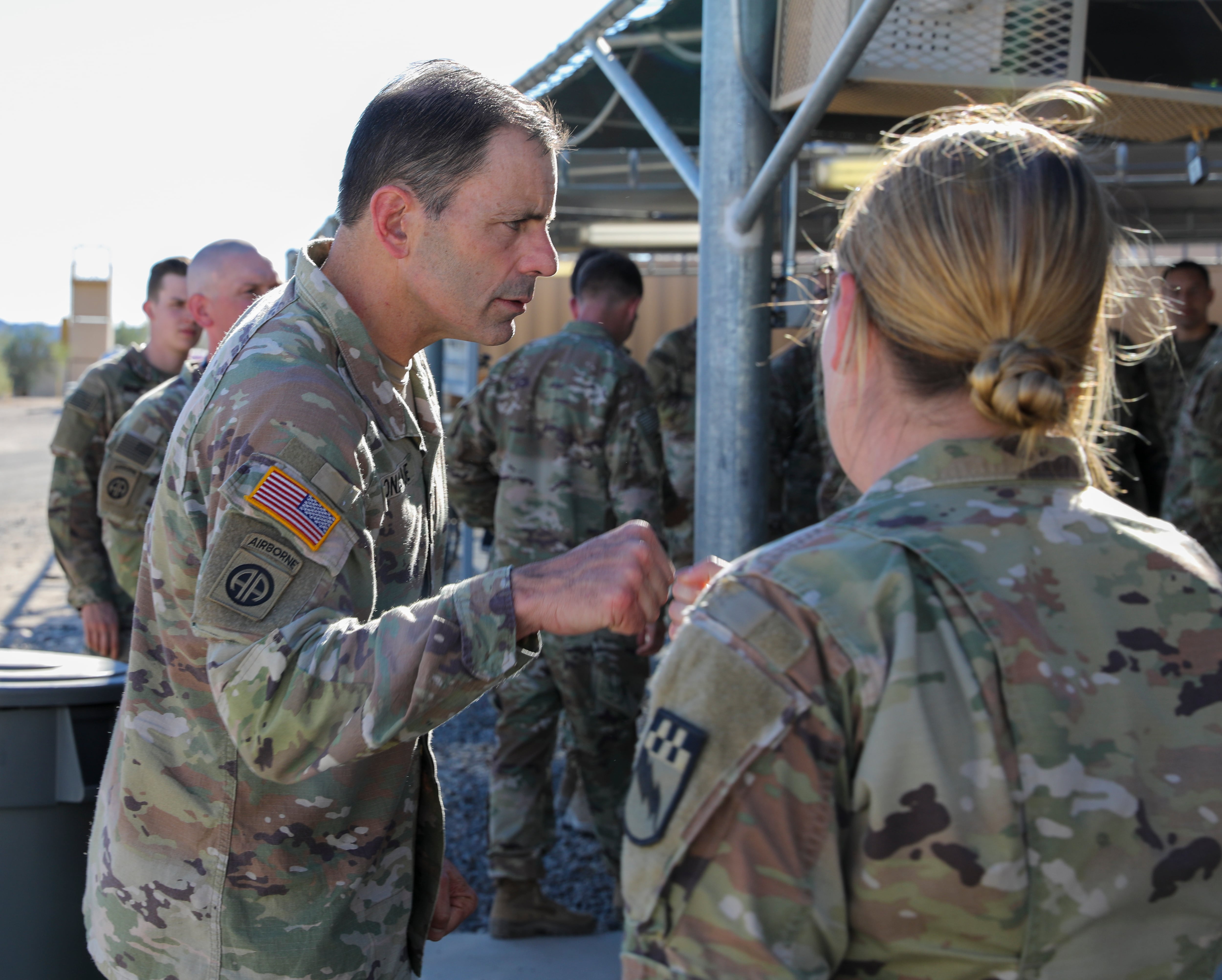YUMA PROVING GROUND, Ariz. — For the last several weeks, the U.S. Army has been experimenting with its newest, most cutting-edge technologies at Yuma Proving Ground as part of its second annual Project Convergence event.
Located just north of Yuma, a quiet little city on the border of Mexico and California, the base isn’t exactly the most welcoming environment. It’s surrounded by sparse vegetation, dry craggy earth and jagged crops of mountains — beautiful, but inhospitable. While the mornings are cool in November, the rising desert sun will quickly bring the temperature up into the eighties. In the summer, it will easily rise to over one hundred degrees.
This is the harsh environment where the Army wants to test its technology — to see what breaks and what is rugged and reliable enough to deploy with its soldiers.
“The idea is the sooner we can bring things out here, get them in the dirt, get them in soldiers’ hands, the sooner we can learn and inform those concepts and we can inform those requirements’ documents,” Col. Andre’ Abadie, special advisor to the deputy commanding general and co-lead for Army Futures Command’s Project Convergence Operational Planning Team told reporters gathered at Yuma Proving Ground. “The idea is to have them out here, have them demonstrated, and then our acquisitions partners can help pull them across that infamous valley of death.”
Project Convergence kicked off in 2020 as the Army’s so-called “campaign of learning.” Project Convergence is a scaled up demonstration of the emerging technologies — experimental networks, artificial intelligence — Army officials say they need to win on the battlefield in the not too distant year of 2030.
RELATED

Project Convergence is also the Army’s contribution to Joint All-Domain Command and Control, the Department of Defense’s concept to connect sensors from every domain to create a common operating picture that can be used to coordinate responses across the joint force. JADC2, explained Abadie, progresses the discussion from kill chains to kill webs. Instead of having a single, linear pipeline from one sensor to one shooter, the kill web creates a network of pathways that can connect any sensor to the best shooter, regardless of the domain or the service.
In 2020, the Army was able to demonstrate a massive leap forward, using new networks, artificial intelligence, and command-and-control tools to cut down the sensor to shooter timeline — the time from detecting a threat to launching a response — from 20 minutes to just 20 seconds.
With Project Convergence 2021, the Army focused less on further cutting down that timeline and put its resources into expanding the effort on several fronts: scaling up the technology experimentation, using actual soldiers for feedback and testing, and bringing in joint partners from the Air Force, Space Force, Navy and Marine Corps.
Putting the joint in JADC2
The first Project Convergence was largely a solo affair for the Army. Apart from the somewhat spontaneous loan of a U.S. Marine Corps F-35B from a nearby base to the experiment, the first iteration was largely devoid of participation from the other services. In 2021, the Army wanted bring the joint forces in to the experiment.
“Project Convergence ‘21 ... could have never happened if it weren’t for the joint partners coming together and truly collaborating, truly buying into this idea of learning, this idea of experimenting,” said Abadie.
Of the seven operational scenarios the Army used to test its technologies, three emphasized the joint force. Those three scenarios focused on the following capabilities:
- Creating a common operations picture and situational awareness
- Engaging in joint air and missile defense
- Conducting joint fires
Including the other services at Project Convergence marks a step forward for JADC2, a concept frequently characterized by its fragmented development. While the Army has Project Convergence, the Air Force has the Advanced Battle Management System and the Navy has Project Overmatch. ABMS has struggled to win support from Congress, undergoing a massive shift after Congress funded the program at only half the requested levels, while Project Overmatch remains a heavily classified effort.
Those implementations of JADC2 have been siloed, with each service developing JADC2 capabilities largely independently. Only recently has the Joint Staff stepped in to begin offering guidance on development. Project Convergence 2021 offered the largest scale effort to tie those disparate efforts together, with teams on the ground working together to make sure data from one service can feed into another and manging the complicated minutia of joint operations in real world demonstrations.
Gen. Mike Murray, the head of Army Futures Command, said he was satisfied with the contributions of the other services to Project Convergence this year. That participation, he added, was made possible by the creation of a three star-level joint board of directors in December 2020 with participation from the Army, Air Force, Navy and Marine Corps. The Space Force joined later on. That board decided what technologies would be brought for experimentation and what operational scenarios would be played out during the nearly two-month event.
Following her visit to Yuma Proving Ground Nov. 9, Army Secretary Christine Wormuth praised the involvement of the other services in Project Convergence.
“I think the thing that I’m most pleased about and maybe most surprised about is the level of joint participation,” she said. “I think what you really saw in Project Convergence today was the services working together against a common challenge.”

While the Army plans to build on that joint cooperation at Project Convergence 2022, Murray said he’d be “thrilled” to participate more in JADC2 efforts hosted by the other services.
“From the Army’s perspective, there is no way we can do this as a single service. We have got to figure out how to do this together,” he said.
Along with the services, Abadie said the event included significant participation from the Joint Staff. The J7, which drives concepts with the Joint Staff, laid out what it wanted to see to the Army, while the J6 “made sure we stayed on path in terms of how we conformed with their efforts and progressed their efforts,” he said. As the military struggled to create a joint common operating picture, the Joint Staff sent a team to Yuma to sit down with operators to understand the challenges of integrating the services’ data.
“As we track the way the Joint Staff is leading that effort and how they are developing and implementing the JADC2 strategy, we’re trying to inform that,” said Abadie.
And finally, Project Convergence 2021 was held with the combatant commanders — the generals who will execute operations with the joint forces — in mind. Specifically, the event tried to simulate the circumstances faced by Indo-Pacific Command, replicating the vast distances forces will face in that region.
Operational scenarios used more than half a dozen locations spread out across the continental United States, said Abadie, including Joint Base Lewis-McChord in Washington State and White Sands Missile Range in New Mexico.
Failure is the goal — kind of
In 2021, the Army brought more than 110 technologies to Arizona for experimentation. They were able to test 27 different combinations of sensors and shooters, using 15 types of sensors and 19 types of shooters. In 2020, the service could only do six meaningful sensor/shooter combinations.
“I’ve seen exponential progress since last year,” said Army Chief of Staff Gen. James McConville.
But Project Convergence isn’t all about success stories. Not everything worked. However, those failures are just as important to the experiment as the successes.
“Did everything work? No, it still didn’t. I mean, it’s the network. It doesn’t work,” said Abadie. “But we had the right leaders out there to drive significant progress for what the network can be.”
The Army had 300 data collectors at Yuma Proving Ground, collecting information on everything — including things that didn’t go as planned.
“I want to break things — to some degree — so I can understand the point of failure,” Abadie said.
Learning what makes a given piece of technology fail in the prototype stage helps engineers address and resolve that problem before it finds its way into the field.
The enemy has a vote, noted Abadie. Near-peer adversaries have technologies that can disrupt the networks U.S. forces rely on or spoof the positioning, navigation and timing signal they need to operate. At Project Convergence 2021, the Army tried to recreate the denied and degraded conditions they will face from enemy forces, allowing soldiers and engineers on the ground learn how their technology will be impacted and how they can make their systems more resilient.
Adding the soldiers’ touch
The first Project Convergence aimed to find out if scientists, engineers and technicians could make it all work. This year, a major focus was the involvement of soldiers so they could get their hands on the technologies and provide feedback.
The 82nd Airborne Division, recently returned from Afghanistan, and a multidomain task force were on hand to ensure devices, vehicles and software had soldier-centric designs. Not only did that mean testing new equipment and platforms, but also offering solutions to make experimental designs more effective. Army officials said soldiers at the event frequently used technology in unexpected and innovative ways, expanding engineers’ understanding of what that technology could do.
“They’re taking the existing technology, and this future technology and they’re bringing it together,. They’re the ones solving the problems,” said Maj. Gen. Christopher Donahue, commander of the 82nd Airborne Division. “They’re the ones creating what they’re going to be fighting with.”

“What our soldiers have conveyed to me is an excitement, because ... the young men and women recognize the value of rapid iteration,” said Brig. Gen. Jim Isenhower, who leads the multidomain task force. “They see what we have been able to do with PC21 and also at exercises before — to come in, look at an architecture, figure out how we have to adjust it, have the expertise there to make those changes, and then the positive feedback they get from proposing solutions or identifying requirements and being able to change so quickly — [it] is really valuable,”
By testing systems with soldier feedback before purchasing them, the Army can receive better equipment and get it into the hands of soldiers faster, said McConville. Plus the service already knows the technology will work.
Is there an end in sight?
The experimentation of Project Convergence continues in spirit long past the actual event, with Army Futures Command’s cross-functional teams hosting and participating in more than two dozen events over the course of the year.
Project Convergence itself is expected to continue on an annual basis for several years.
“This is not a one-year- — and now it’s two years — and-we’re-done kind of thing. Our leadership says they see this will probably be a decade-long endeavor,” Abadie said.
Wormuth said the ongoing Project Convergence experiments will likely come to an end, but for now they play an important role in helping the Army determine the direction it must take with future acquisitions, all while cementing the foundational nature of the network to Army operations.
The Army already has big plans for Project Convergence 2022, when it will bring coalition partners into the fold. International participation will likely focus on the military’s Five Eyes partners and expand from there. The members of that intelligence sharing alliance are the U.S., Australia, Canada, New Zealand and the United Kingdom.
Some have suggested Project Convergence could expand beyond America’s shores, with parts of the experiment taking place in theater.
But for the thousands of soldiers, engineers and technicians who’ve spent the last several weeks testing equipment in the hot Arizona sun, there’s no time to rest.
“PC22 starts tomorrow,” Murray said.
Nathan Strout covers space, unmanned and intelligence systems for C4ISRNET.





